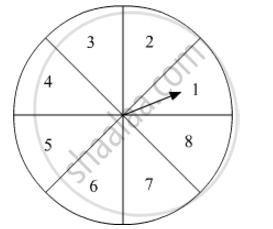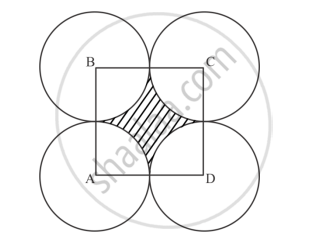Advertisements
Advertisements
प्रश्न
A card is drawn at random from a well shuffled pack of 52 playing cards. Find the probability of getting neither a red card nor a queen.
उत्तर
There are 26 red cards including 2 red queens.
Two more queens along with 26 red cards will be 26 + 2 = 28
∴P(getting a red card or a queen) =`28/52`
∴ P(getting neither a red card nor a queen) = 1 - `28/52=24/52=6/13`
संबंधित प्रश्न
All the red face cards are removed from a pack of 52 playing cards. A card is drawn at random from the remaining cards, after reshuffling them. Find the probability that the drawn card is of red colour.
A game of chance consists of spinning an arrow on a circular board, divided into 8 equal parts, which comes to rest pointing at one of the numbers 1, 2, 3, ..., 8 (Fig. 9), which are equally likely outcomes. What is the probability that the arrow will point at (i) an odd number (ii) a number greater than 3 (iii) a number less than 9.

A bag contains cards numbered from 1 to 49. A card is drawn from the bag at random, after mixing the cards thoroughly. Find the probability that the number on the drawn card is an odd number.
In below Fig., points A, B, C and D are the centers of four circles that each have a radius of length one unit. If a point is selected at random from the interior of square ABCD. What is the probability that the point will be chosen from the shaded region?

Cards numbered from 11 to 60 are kept in a box. If a card is drawn at random from the box, find the probability that the number on the drawn card is a perfect square number.
A box contains 5 red marbels, 8 white marbles and 4 green marbles, One marble is taken out of the box at ramdom. What is the probability that the marble taken out will be not green?
A black die and a white die are thrown at the same time. Write all the possible outcomes. What is the probability? that the product of numbers appearing on the top of the dice is less than 9.
Red queens and black jacks are removed from a pack of 52 playing cards. A card is drawn at random from the remaining cards, after reshuffling them. Find the probability that the card drawn is a face card
If \[\bar{E}\] denote the complement or negation of an even E, what is the value of P(E) + P(\[\bar{E}\]) ?
A number is chosen at random from the number –3, –2, –1, 0, 1, 2, 3. What will be the probability that square of this number is less then or equal to 1?
Two numbers 'a' and 'b' are selected successively without replacement in that order from the integers 1 to 10. The probability that\[\frac{a}{b}\] is an integer, is
A bag contains cards numbered from 1 to 25. A card is drawn at random from the bag. The probability that the number on this card is divisible by both 2 and 3 is
A bag contains 4 white balls, 5 red balls, 2 black balls and 4 green balls. A ball is drawn at random from the bag. Find the probability that it is not green.
A box contains cards bearing numbers 6 to 70. If one card is drawn at random from the box, find the probability that it bears a composite number between 50 and 70.
A bag contains 18 balls out of which x balls are red. If the ball is drawn at random from the bag, what is the probability that it is not red?
A father's age is three times the sum of the ages of his two children. After 5 years his age will be two times the sum of their ages. Find the present age of the father.
I toss three coins together. The possible outcomes are no heads, 1 head, 2 heads and 3 heads. So, I say that probability of no heads is `1/4`. What is wrong with this conclusion?
The probability of getting number 6 in a throw of a dice is `1/6`. Similarly the probability of getting a number 5 is `1/5`.
Ritwik draws a ball from a bag that contains white and yellow balls. The probability of choosing a white ball is `2/9`. If the total number of balls in the bag is 36, find the number of yellow balls.
